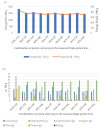Physicochemical, Nutritional, Microstructural, Surface and Sensory Properties of a Model High-Protein Bars Intended for Athletes Depending on the Type of Protein and Syrup Used
- PMID: 35409605
- PMCID: PMC8997551
- DOI: 10.3390/ijerph19073923
Physicochemical, Nutritional, Microstructural, Surface and Sensory Properties of a Model High-Protein Bars Intended for Athletes Depending on the Type of Protein and Syrup Used
Abstract
The main objective of this study was to investigate the possibility of using a combination of vegetable proteins from soybean (SOY), rice (RPC), and pea (PEA) with liquid syrups: tapioca fiber (TF), oligofructose (OF), and maltitol (ML) in the application of high-protein bars to determine the ability of these ingredients to modify the textural, physicochemical, nutritional, surface properties, microstructure, sensory parameters, and technological suitability. Ten variants of the samples were made, including the control sample made of whey protein concentrate (WPC) in combination with glucose syrup (GS). All combinations used had a positive effect on the hardness reduction of the bars after the storage period. Microstructure and the contact angle showed a large influence on the proteins and syrups used on the features of the manufactured products, primarily on the increased hydrophobicity of the surface of samples made of RPC + ML, SOY + OF, and RPC + TF. The combination of proteins and syrups used significantly reduced the sugar content of the product. Water activity (<0.7), dynamic viscosity (<27 mPas∙g/cm3), and sensory analysis (the highest final ratings) showed that bars made of RPC + OF, SOY + OF, and SOY + ML are characterized by a high potential for use in this type of products.
Keywords: contact angle; industrial application; liquid fiber; nutritional value; optical microscopy; plant protein.
Conflict of interest statement
The authors declare no conflict of interest.
Figures







References
-
- Jiang Z., Wang K., Zhao X., Li J., Yu R., Fu R., He Y., Zhao P., Oh K.C., Hou J. High-protein nutrition bars: Hardening mechanisms and anti-hardening methods during storage. Food Control. 2021;127:108127. doi: 10.1016/j.foodcont.2021.108127. - DOI
-
- Röttger-Wirtz S., De Boer A. Personalised Nutrition: The EU’s Fragmented Legal Landscape and the Overlooked Implications of EU Food Law. Eur. J. Risk Regul. 2021;12:212–235. doi: 10.1017/err.2020.79. - DOI
-
- Abd El-Salam M.H., El-Shibiny S. Hardness of high protein nutrition bars based on milk protein concentrates: A review. Biointerface Res. Appl. Chem. 2020;10:4914–4921. doi: 10.33263/BRIAC101914921. - DOI
-
- Stávková S., Prudilová H., Toufarová Z., Nagyová L. Factors influencing the consumer behaviour when buying food. Agric. Econ. 2007;53:276–284. doi: 10.17221/983-AGRICECON. - DOI
Publication types
MeSH terms
Substances
LinkOut - more resources
Full Text Sources
Medical
Research Materials
Miscellaneous

